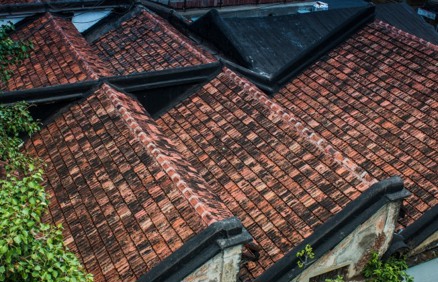Parashat Ki Tezve: On Railings and Rooftops

A look at the ancient rooftops, along with the mitzvah of erecting railings on them.
"When you build a new house, you shall make a railing (ma'ake) for your roof, so that you do not bring bloodguilt on your house if anyone should fall from it" (Devarim 22:8).
The positive injunction of erecting a railing on the rooftop (mitzvat ase 184, Rambam's Sefer HaMitzvot) complements the negative injunction "not to leave a stumbling block" (lo ta'ase 298, 567), and other enactments to preserve life. The Sefer HaChinuch (546) analyzes the laws and ethical issues involved with the caution necessary to safeguard one's life and the lives of others. Despite the fact that G-d watches over each person, and anything that happens to us – for better or for worse – is determined by Divine decree, we are nevertheless charged with taking precautions against dangerous situations. We are not supposed to rely on miracles.
The obligation to erect a railing on the rooftop invites us to take a look at the residential culture in ancient Israel. Several incidents that took place in the period of the Early Prophets are linked to the rooftops (see below). Recent archeological studies also attest to the roof-building techniques used in ancient times.
Residential homes in biblical times had flat rooftops. The roofs of public buildings, such as the king's palace, citadels, sanctuaries, and temples were constructed with stone, especially fortified to withstand heavy loads.
The flat-roof model was prevalent in the Land of Israel—in contrast to the cold European countries, where the slanted roof was the norm. The latter model made inroads to Israel only much later on (around the 19th century), along with the immigrants who brought with them their architectural cultures and lifestyles. The Arab village, to date, has remained with the flat rooftop model, which seems to preserve the architectural style since antiquity.
For many years, a beam system was prevalent: the beams reached the ceiling, with 60 cm separating between each beam. On top of them lay thin wooden planks, upon which a layer of mortar and plaster were spread. To further support the ceiling and roof, additional columns were added inside the homes. Shlomo HaMelech (Mishlei 21:9) asserted that the "corner of the roof" is the safest spot to lean on. The flat rooftops needed to be plastered each year. The time this was done, according to Ta'anit 6a, was with the first rains of the year (yoreh): "[Why is it called] yore? Since it instructs (moreh) people to plaster their roofs."
Roofs were accessed by steps ascending from the inner courtyard, from outside the home, or by ladders.
Various uses for the roof
In biblical times, we find various uses for the roof. Rachav hid the spies on her roof: "Now she had taken them up to the roof and hidden them under some stalks of flax which she had lying on the roof" (Yehoshua 2:6).
The roof served as the venue to dry agricultural produce, stored in large jugs. It was considered private property and concealed from the public. Often, grape vines were trellised on the rooftop, and fruit trees planted near the home hung over the roof. Together, they served as living fences, providing both shade and privacy.
Shimshon, taking his final revenge on the Philistines, wrapped his arms around the columns of the Dagon sanctuary, upon which stood "… some three thousand men and women on the roof watching Shimshon's sport" (Shoftim 16:27). In this case, the roof served as a place of assembly. The people of Thebez also took shelter on the roof of a fortified tower, fleeing from Avimelech (Shoftim 9:51).
The encounters between Shmuel and Shaul took place on the roof: "since there they could speak alone away, far from others' eyes, and exchange secrets" (Da'at Mikra, I Shmuel 9:25–26).
The roof was also a place for relaxation: "Late one afternoon, David rose from his couch and strolled on the roof of the royal palace …" (II Shmuel 11:2). The rooftop of the king's palace was certainly much higher than those of its surroundings; unfortunately, this made it possible for the king to peer into Batsheva's home, the beginning King David's sin. It seems that it was the same roof where Avshalom set up his tent to publicly demonstrate that he took control of David's concubines (II Shmuel 16:22).
The watchmen stood on the roof of the city gates to see who returned from the battle between David and Avshalom (II Shmuel 18:24).
In the times of the later kings of Yehuda, the roof also served as a place for idol worship: "the altars upon the rooftops … fashioned by the kings of Yehuda" (II Melachim 23:12). It was against these altars that the prophet Yeshayahu spoke out fiercely: "What happened to you that you have gone, all of you up on the rooftops?" (Yeshayahu 22:1). Tzefania added: "I will stretch out My arch against … those who bow down on the rooftops to the host of heaven" (1:4–5).
In contrast, in the early Second Temple period, sukkot were set up on the rooftops (as well other places) (Nechemiah 8:16).
The Sassanian Persians of late antiquity buried their dead on the roofs to speed the process of decomposition, in preparation for a second burial.
The cities of antiquity were extremely crowded and condensed, with residents living tongue and jowl. Homes were built connected to one another, often forming a wall. This created a passageway on the rooftops, a sort of pedestrian highway.
The connected rooftops, as mentioned above, served as a venue for drying grapes and figs, and even to raise livestock.
In conclusion, the centrality of the rooftop in ancient times, with its varied uses, sheds light on the reason that erecting a railing on the roof to prevent calamity deserves its own mitzvah.




